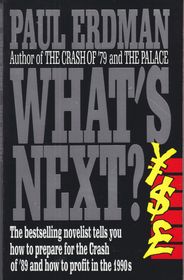tome 7 what's next
| série: | Polar/Erdman |
| éditeur: | Bantam Books |
| auteur: | Erdman Paul E. |
| classement: | carton 46 |
| année: | 1988 |
| format: | broché |
| état: | TBE/N |
| valeur: | 5 € |
| critère: | * |
| remarques: | English book the story of the development of an economical period starting with the year 1987 ( = black monday in october 1987 with a downfall of 23% in one day on the stock market which was unique in history) n.b. and what was 1929 in comparison? followed by a period of grace = 1988 when prosperity went slowly down = paradise lost, again followed by the crash of 1989 and the year 1990 = road to recovery >> p. 18 again the dependence on foreign capital >> p. 22 the "bandwagon effect" = money invested into the stock market by mutual funds, pension funds and insurance funds >> p. 41 the Keynesian stimulus = Reaganomics (economic policies of Reagan) = creation of prosperity through artificial stimulation of demand by government spendings (causing then deficits) >> p. 51 the theory of the "J-curve", i.e. that a nation's foreign trade gets worse following a currency devaluation and then improving rapidly >> p. 54 the influence of oil imports being the largest item in the US trade deficit (n.b. no longer in 2010) >> p. 57 the case of "oversupply" causing the recession of 1989 either a V-shaped of U-shaped recession >> p. 60 first principle is to watch the market every day but most people simply do not have the time to play the ups and downs of the market >> p. 65 during a recession, one has principally to protect one's own assets on the stock market (n.b. but how?) >> p. 72 history of economic recessions from 1906 to 1989 facit: after a major market downturn, a recession has followed after about one year >> p. 77 the "buyouts" of managers to prevent hostile take-overs from foreign companies so called "asset strippers" (but this usually cost a lot of money!) - the "leveraging" of corporate companies - the "spinning off" = to sell parts of a company separately to make assets >> p. 84 the problem of the third world debt >> p. 85 the convergence theory: 1/ a recession starts always with a reduction of consumer spending 2/ a recession is then influenced by the political tendency of the government confronted with it 3/ unemployment starts and develops 4/ linkage effect = taking the other nations into global recession 5/ the collapse of oil price and petrodollar 6/ the large debt of Latin american countries however Erdman develops here a theme which is well-known >> p. 105 the problem with the OPEC cartel , Saudi Arabia as the "swing producer", the rivalry between the Saudis and the Iranians >>p. 109 the war between Iran and Irak and its effect on the oil price >> p. 113 Mexicans have passed from poverty to misery >> p. 129 the problem of US banks having to get enough cash for their depositors while having to write off reserves for uncollectable debts in LDC (lesser developed countries) >> p. 131 the result hereof being a systematic bank crisis >> p. 157 Switzerland = the safest of the save havens, therefore Swiss banks are always flushed with cash and as a result interest rates in Switzerland are always rather low >> also Switzerland does not regard dodging taxes as a crime (bank secrecy law) >> p. 171 the American magic: high technology, venture capital and entrepreneurship >> this time Erdman is becoming a financial adviser and develops a rather good description of complicate affairs into relatively simple matters |
| couvertures: |  |
Copyright 2008 - 2025 G. Rudolf
